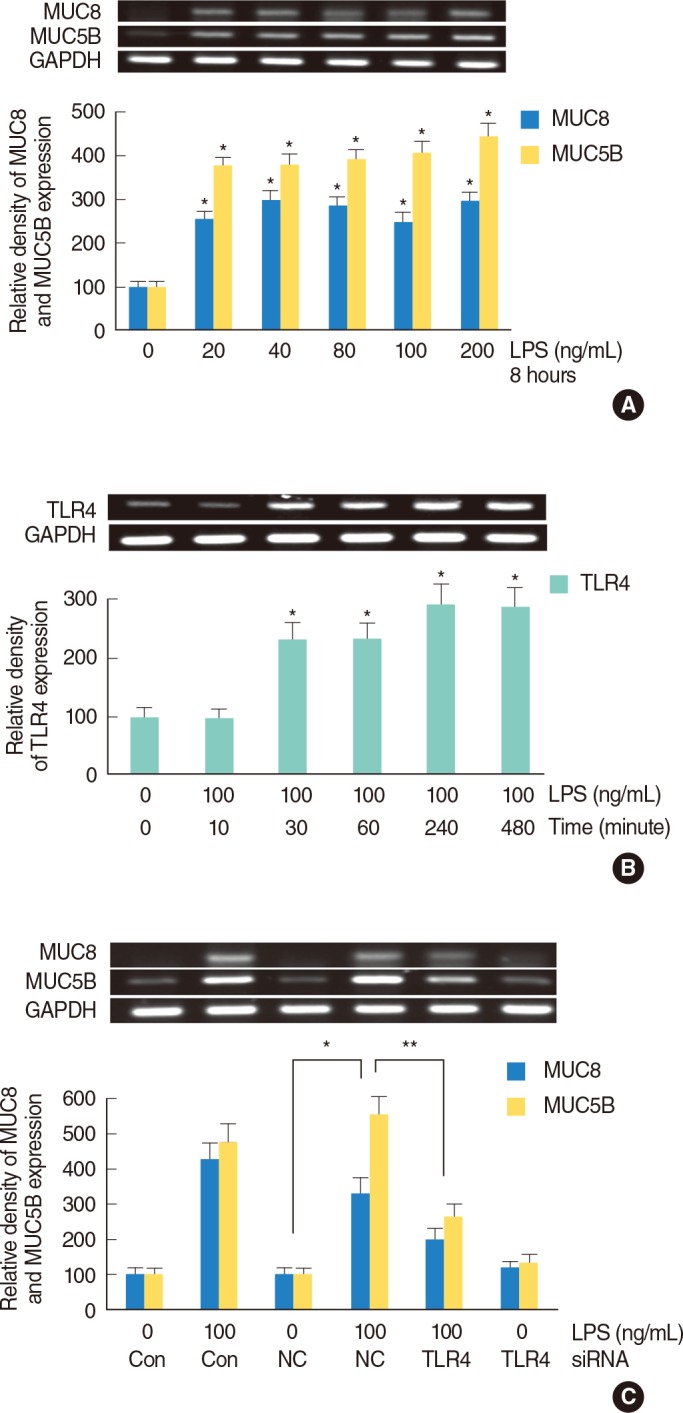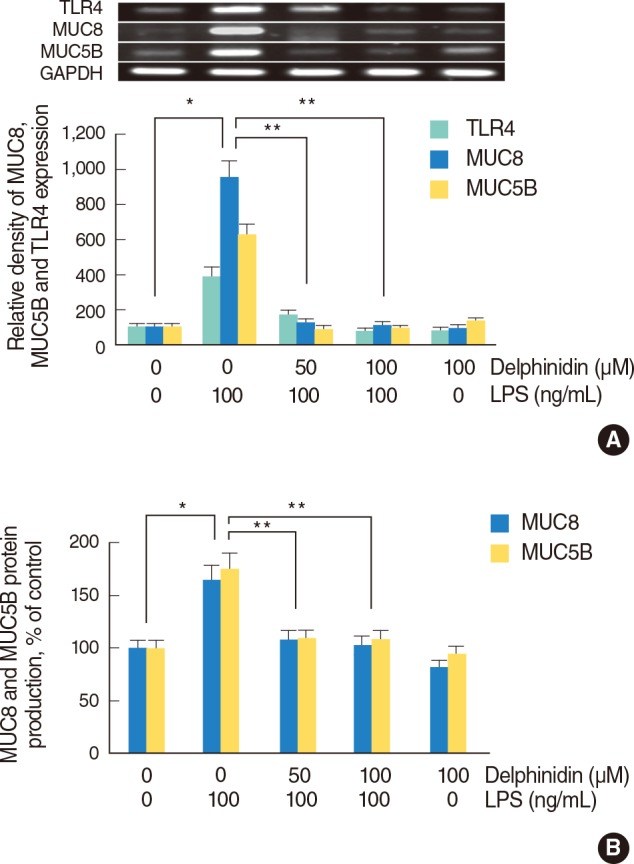Clin Exp Otorhinolaryngol.
2014 Sep;7(3):198-204. 10.3342/ceo.2014.7.3.198.
Delphinidin Inhibits LPS-Induced MUC8 and MUC5B Expression Through Toll-like Receptor 4-Mediated ERK1/2 and p38 MAPK in Human Airway Epithelial Cells
- Affiliations
-
- 1Department of Otorhinolaryngology-Head and Neck surgery, Yeungnam University College of Medicine, Daegu, Korea. ydkim@med.yu.ac.kr
- 2Regional Center for Respiratory Diseases, Yeungnam University Medical Center, Daegu, Korea.
- KMID: 1973470
- DOI: http://doi.org/10.3342/ceo.2014.7.3.198
Abstract
OBJECTIVES
Delphinidin is one of the anthocyanidins. It is believed to have anti-inflammatory property including antioxidant, antiangiogenic, and anti-cancer properties. However, the anti-inflammatory effect of delphinidin in mucin-producing human airway epithelial cells has not been determined. Therefore, this study was conducted in order to investigate the effect and the brief signaling pathway of delphinidin in lipopolysaccharide (LPS)-induced MUC8 and MUC5B expression in human airway epithelial cells.
METHODS
In mucin-producing human NCI-H292 airway epithelial cells and primary cultures of normal nasal epithelial cells, the reverse transcriptase-polymerase chain reaction (RT-PCR), real-time PCR, enzyme immunoassay were used for investigating the expressions of MUC8, MUC5, and Toll-like receptor 4 (TLR4), after LPS treatment and delphinidin treatment. And the signaling pathway of delphinidin on LPS-induced MUC8 and MUC5B expression was investigated using the RT-PCR, and immunoblot analysis. To confirm the involvement of TLR4 in LPS-induced MUC8 and MU5B expression, the cells were transfected with TLR4 siRNA.
RESULTS
In NCI-H292 airway epithelial cells, LPS (100 ng/mL) significantly induced TLR4, MUC8, and MUC5B expression. TLR4 siRNA significantly blocked LPS-induced MUC8 and MUC5B mRNA expression. LPS (100 ng/mL) significantly activated the phosphorylation of extracellular signal related kinase (ERK) 1/2 and p38 mitogen-activated protein kinase (MAPK). Delphinidin (50 and 100 microM) inhibited LPS-induced TLR4, MUC8, and MUC5B expression and LPS-induced phosphorylation of ERK1/2 and p38 MAPK. In the primary cultures of normal nasal epithelial cells, delphinidin (50 and 100 microM) significantly inhibited LPS-induced TLR4, MUC8, and MUC5B gene expression.
CONCLUSION
These results suggest that delphinidin attenuates LPS-induced MUC8 and MUC5B expression through the TLR4-mediated ERK1/2 and p38 MAPK signaling pathway in human airway epithelial cells. These findings indicated that delphinidin may be a therapeutic agent for control of inflammatory airway diseases.
Keyword
MeSH Terms
-
Anthocyanins
Epithelial Cells*
Gene Expression
Humans
Immunoenzyme Techniques
Lipopolysaccharides
p38 Mitogen-Activated Protein Kinases*
Phosphorylation
Phosphotransferases
Protein Kinases
Real-Time Polymerase Chain Reaction
RNA, Messenger
RNA, Small Interfering
Toll-Like Receptor 4
Toll-Like Receptors*
Anthocyanins
Lipopolysaccharides
Phosphotransferases
Protein Kinases
RNA, Messenger
RNA, Small Interfering
Toll-Like Receptor 4
Toll-Like Receptors
p38 Mitogen-Activated Protein Kinases
Figure
Cited by 2 articles
-
Eupatilin downregulates phorbol 12-myristate 13-acetate-induced MUC5AC expression via inhibition of p38/ERK/JNK MAPKs signal pathway in human airway epithelial cells
Yoon-Hee Cheon, Min Seob Kim, Ju-Young Kim, Dong Hyun Kim, Seung Yoon Han, Jae-Hoon Lee
Korean J Physiol Pharmacol. 2020;24(2):157-163. doi: 10.4196/kjpp.2020.24.2.157.Asian Sand Dust Up-Regulates MUC4 Expression in Human Upper Airway Epithelial Cells
Chang-Hwi Park, Yoo Sun Song, Chang Hoon Bae, Yoon Seok Choi, Si-Youn Song, Kyeong-Cheol Shin, Hyun Jung Jin, Yong-Dae Kim
Korean J Otorhinolaryngol-Head Neck Surg. 2017;60(5):222-231. doi: 10.3342/kjorl-hns.2016.17594.
Reference
-
1. Williams OW, Sharafkhaneh A, Kim V, Dickey BF, Evans CM. Airway mucus: from production to secretion. Am J Respir Cell Mol Biol. 2006; 5. 34(5):527–536. PMID: 16415249.2. Ali MS, Pearson JP. Upper airway mucin gene expression: a review. Laryngoscope. 2007; 5. 117(5):932–938. PMID: 17473699.
Article3. Ali Mel-S. Nasosinus mucin expression in normal and inflammatory conditions. Curr Opin Allergy Clin Immunol. 2009; 2. 9(1):10–15. PMID: 19532088.
Article4. Shirato K, Gao C, Ota F, Angata T, Shogomori H, Ohtsubo K, et al. Flagellin/Toll-like receptor 5 response was specifically attenuated by keratan sulfate disaccharide via decreased EGFR phosphorylation in normal human bronchial epithelial cells. Biochem Biophys Res Commun. 2013; 6. 435(3):460–465. PMID: 23680662.
Article5. Joo JH, Ryu JH, Kim CH, Kim HJ, Suh MS, Kim JO, et al. Dual oxidase 2 is essential for the toll-like receptor 5-mediated inflammatory response in airway mucosa. Antioxid Redox Signal. 2012; 1. 16(1):57–70. PMID: 21714724.
Article6. Zhang S, Nie S, Huang D, Huang J, Wang Y, Xie M. Polysaccharide from Ganoderma atrum evokes antitumor activity via toll-like receptor 4-mediated NF-κB and mitogen-activated protein kinase signaling pathways. J Agric Food Chem. 2013; 4. 61(15):3676–3682. PMID: 23514335.
Article7. Koide T, Hashimoto Y, Kamei H, Kojima T, Hasegawa M, Terabe K. Antitumor effect of anthocyanin fractions extracted from red soybeans and red beans in vitro and in vivo. Cancer Biother Radiopharm. 1997; 8. 12(4):277–280. PMID: 10851476.
Article8. Galvano F, La Fauci L, Lazzarino G, Fogliano V, Ritieni A, Ciappellano S, et al. Cyanidins: metabolism and biological properties. J Nutr Biochem. 2004; 1. 15(1):2–11. PMID: 14711454.
Article9. Matsunaga N, Tsuruma K, Shimazawa M, Yokota S, Hara H. Inhibitory actions of bilberry anthocyanidins on angiogenesis. Phytother Res. 2010; 1. 24(Suppl 1):S42–S47. PMID: 19496063.
Article10. Johnson MH, de Mejia EG, Fan J, Lila MA, Yousef GG. Anthocyanins and proanthocyanidins from blueberry-blackberry fermented beverages inhibit markers of inflammation in macrophages and carbohydrate-utilizing enzymes in vitro. Mol Nutr Food Res. 2013; 7. 57(7):1182–1197. PMID: 23526625.
Article11. Jakesevic M, Xu J, Aaby K, Jeppsson B, Ahrne S, Molin G. Effects of bilberry (Vaccinium myrtillus) in combination with lactic acid bacteria on intestinal oxidative stress induced by ischemia-reperfusion in mouse. J Agric Food Chem. 2013; 4. 61(14):3468–3478. PMID: 23488931.
Article12. Hou DX, Yanagita T, Uto T, Masuzaki S, Fujii M. Anthocyanidins inhibit cyclooxygenase-2 expression in LPS-evoked macrophages: structure-activity relationship and molecular mechanisms involved. Biochem Pharmacol. 2005; 8. 70(3):417–425. PMID: 15963474.
Article13. Smirnova MG, Guo L, Birchall JP, Pearson JP. LPS up-regulates mucin and cytokine mRNA expression and stimulates mucin and cytokine secretion in goblet cells. Cell Immunol. 2003; 1. 221(1):42–49. PMID: 12742381.
Article14. Woo HJ, Yoo WJ, Bae CH, Song SY, Kim YW, Park SY, et al. Leptin up-regulates MUC5B expression in human airway epithelial cells via mitogen-activated protein kinase pathway. Exp Lung Res. 2010; 6. 36(5):262–269. PMID: 20497020.
Article15. Turner J, Jones CE. Regulation of mucin expression in respiratory disesase. Biochem Soc Trans. 2009; 8. 37(4):877–881. PMID: 19614611.16. Kagan JC, Medzhitov R. Phosphoinositide-mediated adaptor recruitement controls toll-like receptor signaling. Cell. 2006; 6. 125(5):943–955. PMID: 16751103.17. Lu YC, Yeh WC, Ohashi PS. LPS/TLR4 signaling transduction pathway. Cytokine. 2008; 5. 42(2):145–151. PMID: 18304834.18. Wang Y, Shen Y, Li K, Zhang P, Wang G, Gao L, et al. Role of matrix metalloproteinase-9 in lipopolysaccharide-induced mucin production in human airway epithelial cells. Arch Biochem Biophys. 2009; 6. 486(2):111–118. PMID: 19389382.
Article19. Kim JM, Kim KM, Park EH, Seo JH, Song JY, Shin SC, et al. Anthocyanins from black soybean inhibit Helicobacter pylori-induced inflammation in human gastric epithelial AGS cells. Microbiol Immunol. 2013; 5. 57(5):366–373. PMID: 23668609.
- Full Text Links
- Actions
-
Cited
- CITED
-
- Close
- Share
- Similar articles
-
- Effect of Udenafil on MUC5B Expression in Human Airway Epithelial Cells
- Effect of Polyinosinic-Polycytidylic Acid on MUC5B Expression in Human Airway Epithelial Cells
- Effect of Resolvin D1 and E1 on Mucin Expression in Human Airway Epithelial Cells
- Roxithromycin Suppresses MUC5B/8 Mucin Genes and Mucin Production in Airway Epithelial Cells
- Effect of Anthocyanidin on MUC5AC and MUC5B Expression in Airway Epithelial Cells





